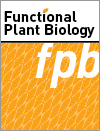Ver ítem
- xmlui.general.dspace_homeCentros Regionales y EEAsCentro Regional Buenos Aires NorteEEA PergaminoArtículos científicosxmlui.ArtifactBrowser.ItemViewer.trail
- Inicio
- Centros Regionales y EEAs
- Centro Regional Buenos Aires Norte
- EEA Pergamino
- Artículos científicos
- Ver ítem
Yield determinants, root distribution and soil water uptake in maize (Zea mays) hybrids differing in canopy senescence under post-silking drought
Resumen
Delayed canopy senescence or ‘stay-green’ (SG) trait in maize (Zea mays L.) could improve drought tolerance. Two field trials comparing four to six maize hybrids with different senescence rate were carried out at Buenos Aires, Argentina, varying water availability during the reproductive period. Green leaf area at maturity was related to kernel weight (r2 = 0.94***) but its relationship with yield was weaker (r2 = 0.51–53*) and post-silking dry matter
[ver mas...]
Delayed canopy senescence or ‘stay-green’ (SG) trait in maize (Zea mays L.) could improve drought tolerance. Two field trials comparing four to six maize hybrids with different senescence rate were carried out at Buenos Aires, Argentina, varying water availability during the reproductive period. Green leaf area at maturity was related to kernel weight (r2 = 0.94***) but its relationship with yield was weaker (r2 = 0.51–53*) and post-silking dry matter remobilisation was negatively related with the SG trait (r2 = 0.84**). Two additional experiments were carried out in 63 L pots by withholding irrigation in half of the pots after silking. The SG hybrid achieved lower root biomass at silking, a shallower root distribution and larger root growth in the post-silking period. Under drought conditions, stomatal conductance was lower in the SG hybrid but photosynthetic electron transport rate was higher. Higher post-silking dry matter assimilation in the SG hybrid was compensated for by higher dry matter remobilisation in the non-SG. Higher kernel number per plant in the non-SG hybrid with no ability to compensate for by higher kernel weight in the SG, resulted in slightly higher yields in the non-SG under drought. A water conservation strategy associated with a shallower root system could be linked to the SG trait, promoting faster water depletion at upper soil levels and reduced stomatal conductance at the leaf level but with no conclusive yield advantage.
[Cerrar]

Autor
Antonietta, Mariana;
Maydup, María Luján;
Cano, María Gabriela;
Fanello, Diego Darío;
Acciaresi, Horacio Abel;
Guiamet, Juan José;
Fuente
Functional Plant Biology 48 (11) : 1124-1138. (2021)
Fecha
2021-05
Editorial
CSIRO Publishing
ISSN
1445-4408
1445-4416 (online)
1445-4416 (online)
Formato
pdf
Tipo de documento
artículo
Palabras Claves
Derechos de acceso
Restringido
 Excepto donde se diga explicitamente, este item se publica bajo la siguiente descripción: Creative Commons Attribution-NonCommercial-ShareAlike 2.5 Unported (CC BY-NC-SA 2.5)
Excepto donde se diga explicitamente, este item se publica bajo la siguiente descripción: Creative Commons Attribution-NonCommercial-ShareAlike 2.5 Unported (CC BY-NC-SA 2.5)

